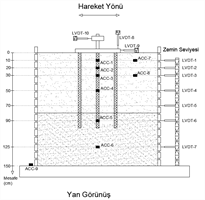The purpose of this project, in which the shaking table in the Structural and Earthquake Engineering Laboratory of our faculty is used, is to develop soil-pile resistance-deflection (p-y) relation especially for group piles in sands under seismic waves propagating through the soil from the bedrock. Unlike the current studies in the literature, the effect of nonlinear dynamic behavior of the soil during seismic waves propagating from the bedrock toward the surface on the p-y curves will be investigated and the p-y relationships will be developed for piles in a group (without the group effect) instead of using the p-y relations for single piles.
You can find the detailed explanation about the project, coordinated by Assist. Prof. Dr. Esra Ece Bayat, below.


Project Title: Development of lateral load resistance-deflection curves for piles in sands under earthquake excitation
Project Number: TUBİTAK-119M624
Project Coordinator: Assist. Prof. Dr. Esra Ece Bayat
Abstract:
In recent years, the use of pile foundations in design becomes necessary with the rising demand in high-rise buildings with complex architectural design. Under the earthquake load, the soil-pile-superstructure system behaves together and the behavior of each component affects the other, which is defined as soil-structure interaction. (SSI). SSI analysis is crucial especially in some residential buildings, as well as in special structures such as high-rise structures, bridges, nuclear structures and hospitals. For the first time in history, the design of the pile foundations under earthquake load has been included in the new Turkish Earthquake Resistant Building Design Regulation (TBDY, 2019) and soil-structure interaction analysis has become mandatory for structures with pile foundations. The common trend in practice is to model the soil with springs instead of modeling it as 3D continuum. In this method, the behavior of soil-pile interface is represented by nonlinear springs defined at specified depths along the pile. The purpose of this project is to develop soil-pile resistance-deflection (p-y) relation especially for group piles in sands under seismic waves propagating through the soil from the bedrock. Unlike the current studies in the literature, the effect of nonlinear dynamic behavior of the soil during seismic waves propagating from the bedrock toward the surface on the p-y curves will be investigated and the p-y relationships will be developed for piles in a group (without the group effect) instead of using the p-y relations for single piles. For this purpose, numerical analyses and 1-g model tests are planned to be performed in parallel to understand the effect of the period of the building, the amplitude and the frequency (f) of the harmonic acceleration-time histories (amax), soil relative density (DR), the pile diameter and number of piles on the p-y relations. The p-y relations that will be explored in FLAC 3D software, will be validated in ACS SASSI (System for Analysis of Soil Structure Interaction) software program. The model experiments will be performed in a laminar box to be placed on a shaking table. Building models with different periods with 2x2 group piles embedded into the sand will be tested inside the laminar box, that will be excited under several harmonic displacement-time history records. As a result of these studies, soil-pile interaction correlations (p-y), which have the effect of nonlinear behavior of the soil, for piles without group effect under earthquake loads will be developed. In our country, there has not been conducted such a comprehensive research study on the soil-pile interaction, which is essential in the designs of these types of structures. Thus, with the project outputs, it is expected to reduce the dependence on international firms in the designs of these structures.